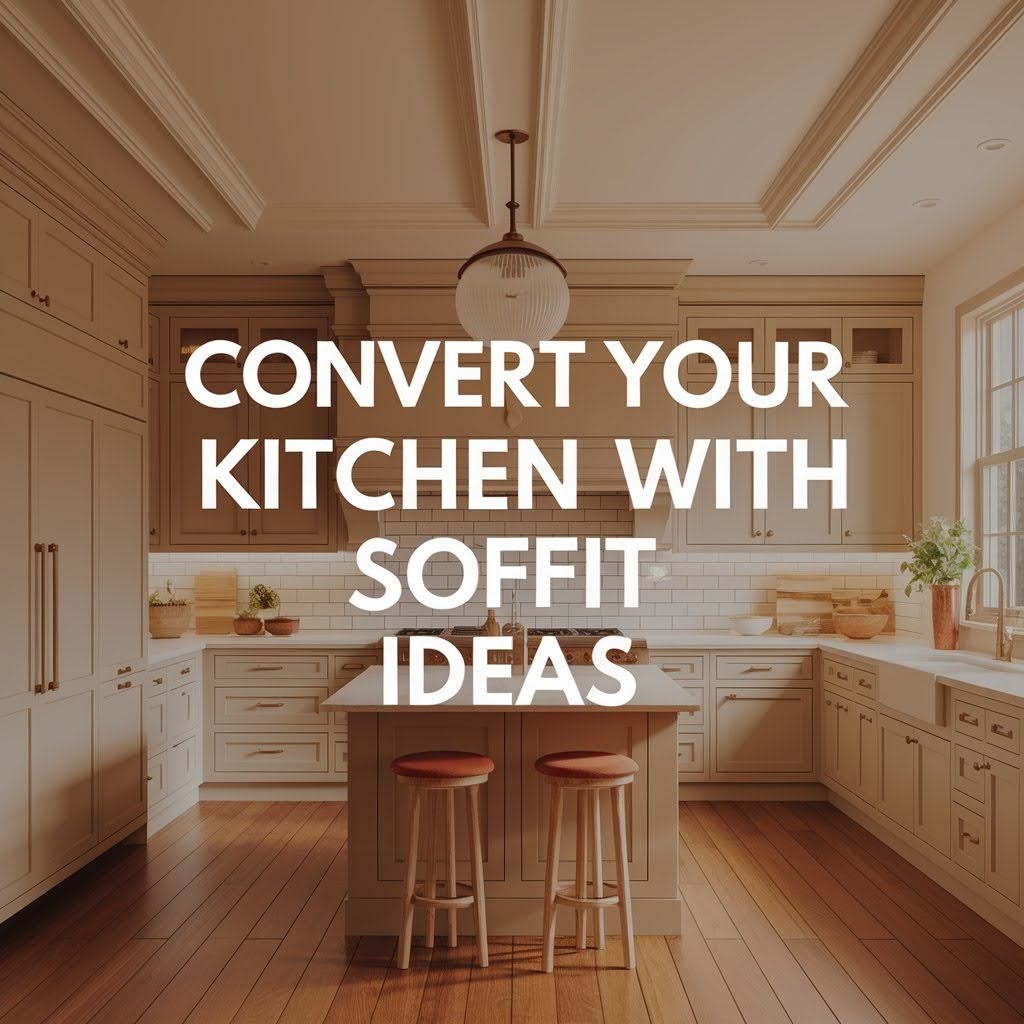Kitchen soffits are those boxed-in areas between your upper cabinets and ceiling. Many homeowners see them as awkward spaces that collect dust and make kitchens feel cramped. But here’s the truth: soffits hold massive potential for improving your kitchen’s function and style.
This article shows you practical ways to work with your soffits instead of against them. You’ll learn how to hide them, use them for storage, or remove them completely. We’ll cover the costs, the challenges, and the results you can expect.
I’ve helped hundreds of homeowners tackle this exact problem over the past decade. The solutions I’m sharing come from real projects and real results. No fluff or empty promises.
By the end, you’ll know exactly which soffit approach works best for your space and budget. Your kitchen conversion starts here.
What Is a Kitchen Soffit?
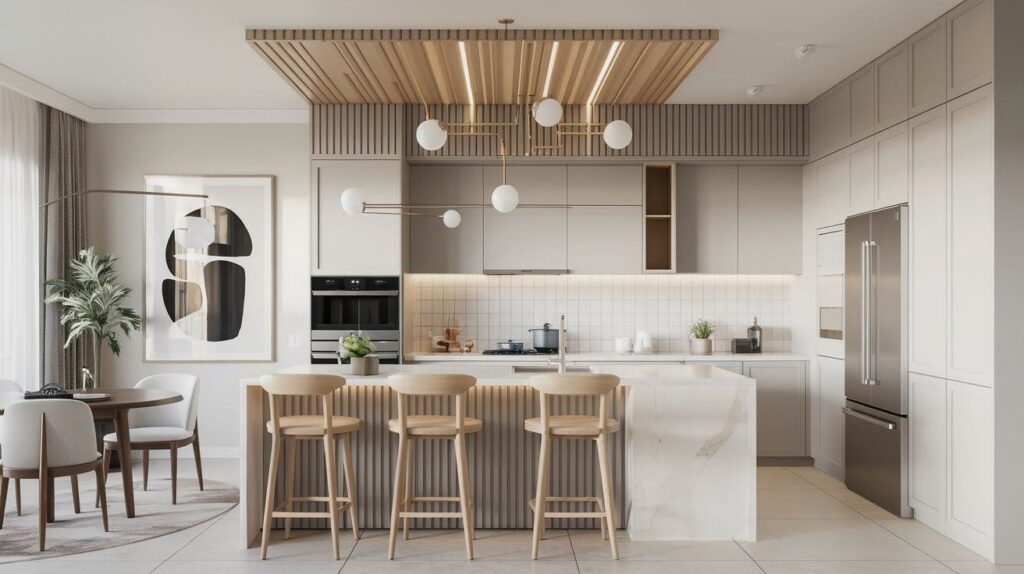
A kitchen soffit is a boxed structure above cabinets that hides pipes, wiring, and other utilities for a cleaner look.
Definition and Purpose
A kitchen soffit is basically a box-like structure that fills the gap between your upper cabinets and the ceiling. Think of it as a cover-up job for all the messy stuff you don’t want to see.
Soffits serve a practical purpose. They hide important utilities like:
- Water pipes and gas lines
- Electrical wiring and outlets
- HVAC ducts and vents
- Structural beams that can’t be moved
Without soffits, you’d see all these systems running across your ceiling. Not exactly the look most people want in their kitchen.
Looks Matter Too
Soffits also play a visual role in your kitchen design. They create a clean line between your cabinets and ceiling, making everything look more finished and intentional.
When done right, soffits help your cabinets appear taller and more substantial. They fill that awkward gap that would otherwise break up the flow of your kitchen’s vertical lines.
The result? A more cohesive space that feels planned rather than pieced together.
Why Upgrade Your Kitchen Soffit?
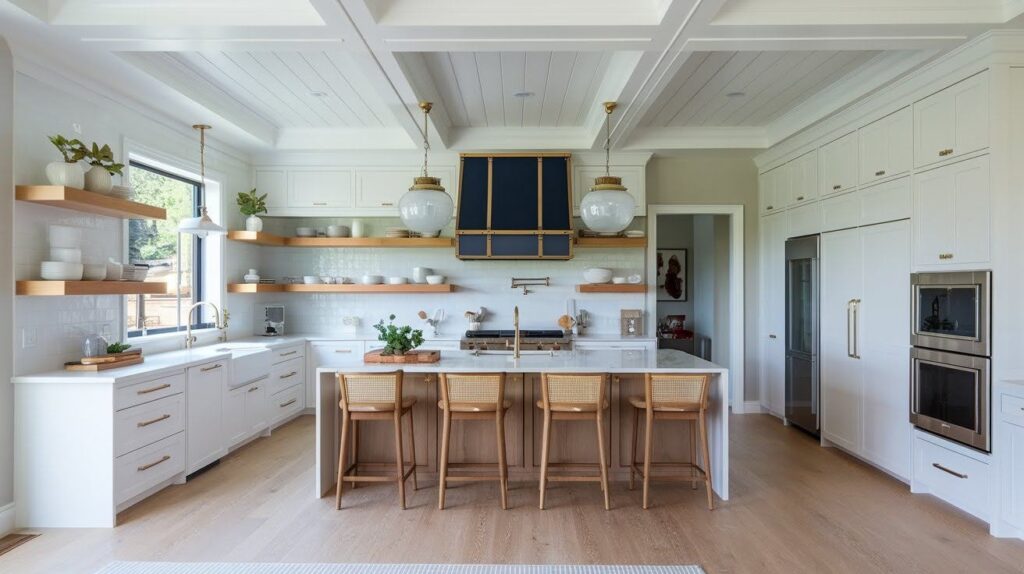
Turn your kitchen soffit into a functional and stylish feature that adds storage, lighting, and visual flow to your space.
Make Your Space Work Harder
Most kitchen soffits just sit there doing nothing but hiding pipes. That’s wasted potential. Smart homeowners are turning these dead zones into functional assets.
You can convert your soffit into:
- Built-in lighting that brightens your workspace
- Extra storage for items you don’t use daily
- Display space for plants or collectibles
- Wine storage or spice racks
Think about it – you’re already paying for that square footage. Why not make it earn its keep?
Visual Impact That Counts
A well-planned soffit upgrade changes how your entire kitchen feels. Plain, boxy soffits make kitchens look dated and choppy. Updated versions create visual flow and character.
Modern soffit treatments can:
- Add depth and dimension to flat walls
- Create focal points that draw the eye upward
- Make standard-height ceilings feel taller
- Connect different design elements throughout the room
The difference is dramatic. Your kitchen goes from looking like separate pieces stuck together to feeling like one unified space that was designed with intention.
Top Soffit Conversion Ideas
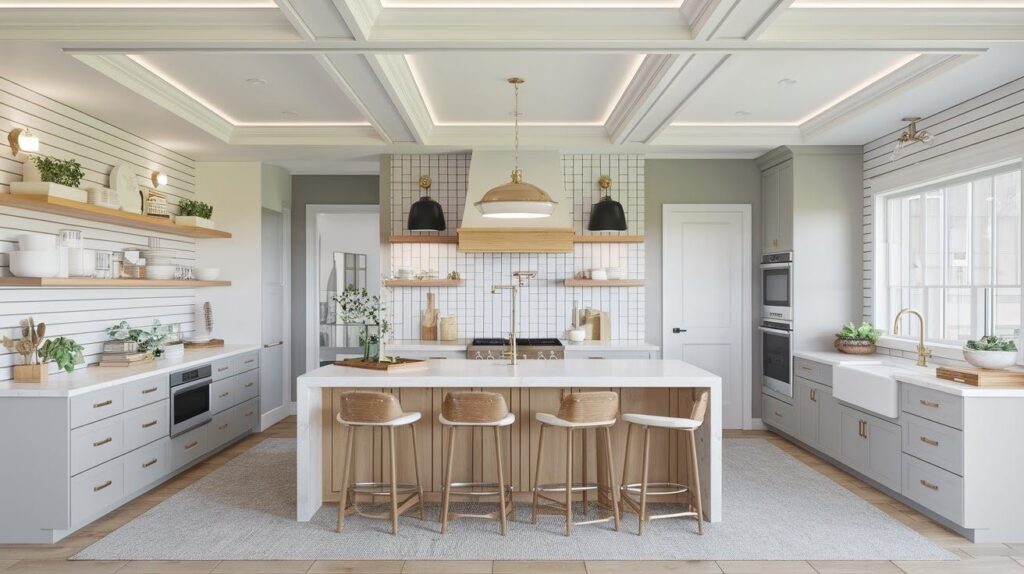
Transform your kitchen soffit with paint, lighting, crown molding, or even plants to blend style, function, and personality into an often-overlooked space.
Paint and Blend
The simplest fix often works best. Paint your soffit the same color as your cabinets to make it disappear into the background. This creates one continuous visual line that makes your kitchen feel more spacious.
Want to make a statement instead? Go bold with a contrasting color. Dark soffits can make white cabinets pop. Light soffits can brighten up dark cabinetry.
For extra personality, try stencils or simple patterns. Geometric designs or subtle textures can turn a boring soffit into a conversation starter.
Add Crown Molding
Crown molding is the classic upgrade that never goes out of style. It softens the harsh line where your soffit meets the ceiling and gives your kitchen a more expensive, custom look.
This works especially well in traditional or transitional kitchens. The molding creates architectural detail that makes your space feel more thoughtfully designed.
Light It Up
Good lighting converts any kitchen. Your soffit is prime real estate for both task and mood lighting.
Recessed lights provide focused illumination for your countertops. LED strip lighting creates a warm glow that makes your kitchen feel cozy in the evenings.
Under-cabinet lighting combined with soffit lighting creates layers of light that make cooking easier and entertaining more pleasant.
Custom Storage Solutions
Turn wasted space into working space. Convert your soffit into shallow cabinets perfect for storing items you don’t reach for daily.
Think holiday dishes, serving platters, or small appliances you only use occasionally. Open shelving works too – just make sure you’re okay with keeping those shelves organized since they’re always visible.
Use Tile Finishes
Extend your backsplash tile right up onto the soffit. This creates a seamless flow that makes your walls look taller and more expensive.
Subway tile, natural stone, or mosaic patterns can add texture and visual interest. The continuous material makes your kitchen feel more cohesive and professionally designed.
Show Off Your Style
Turn your soffit into a display area for things you love. Rotate seasonal decorations, showcase your favorite dishes, or display artwork that reflects your personality.
The key is keeping it simple. Too much clutter makes your kitchen feel busy and cramped.
Bring Nature Inside
Plants make any space feel more alive. Your soffit can hold small potted herbs, trailing plants, or even a compact herb garden.
If maintenance isn’t your thing, high-quality artificial plants work just as well. Choose realistic options that add color and life without the watering schedule.
Classic vs Modern Soffit Styles
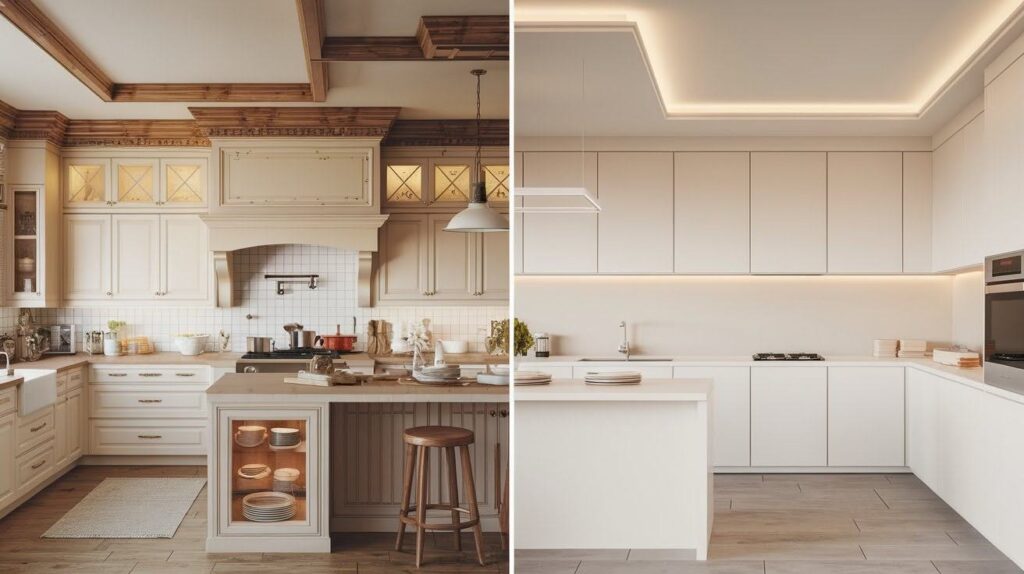
Classic soffits use trim, warm neutrals, and subtle lighting for timeless charm, while modern soffits embrace clean lines, minimalism, and sleek LED lighting for a seamless contemporary look.
Classic Soffit Styling
Traditional kitchens call for timeless approaches that feel warm and inviting. Classic soffits rely on quality materials and proven design principles that have worked for decades.
Wood molding and trim are the foundation here. Think detailed crown molding, raised panels, or beadboard finishes that match your cabinet style. These elements add depth and character that makes your kitchen feel established and thoughtful.
Color choices lean toward neutral territory – warm whites, soft creams, or colors that complement your existing cabinetry. The goal is harmony, not contrast.
Lighting stays subtle and functional. Warm-toned bulbs in traditional fixtures create the kind of cozy atmosphere that makes people want to linger in your kitchen.
Modern Soffit Concepts
Contemporary kitchens take a completely different approach. Here, less is definitely more. Clean lines and simple forms create visual calm in busy spaces.
Modern soffits often feature flat surfaces with minimal or no trim. When molding appears, it’s geometric and understated. The focus is on smooth transitions and uninterrupted sight lines.
LED strip lighting is a modern favorite. These slim fixtures provide even illumination while staying practically invisible. The light itself becomes the design element.
Color palettes stick to one or two tones. Monochromatic schemes – like white cabinets with white soffits – create that seamless, gallery-like feel that defines contemporary design.
The result is clean, uncluttered, and focused on function over ornamentation.
DIY vs Professional Soffit Makeover
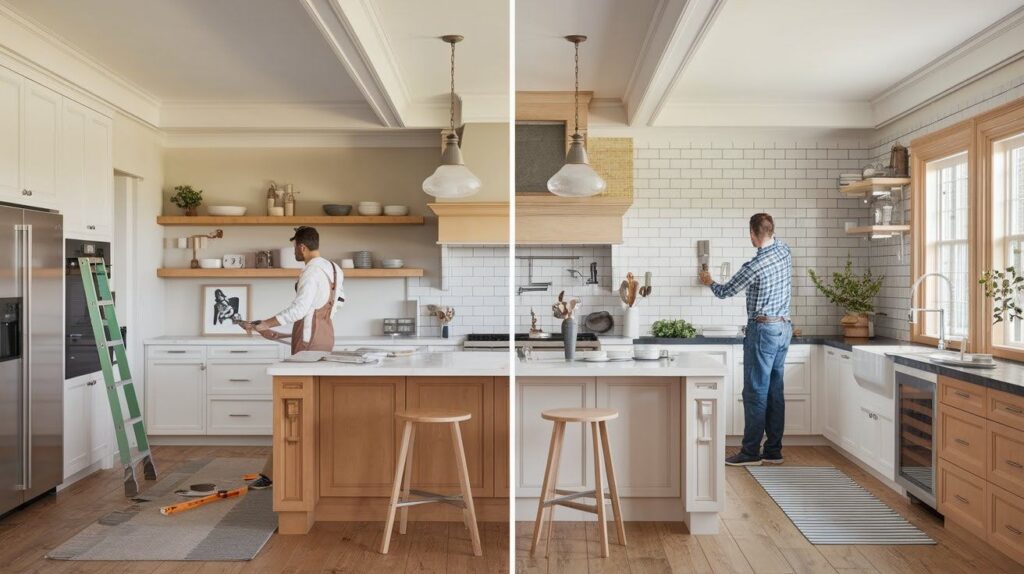
DIY-friendly soffit upgrades include painting and basic molding, while projects involving electrical work or custom cabinetry are best left to professionals for safety and precision.
What You Can Handle Yourself
Many soffit upgrades are perfect weekend projects that don’t require special skills or expensive tools. If you’re comfortable with basic home improvement tasks, these options can save you serious money.
Painting is the most straightforward DIY option. A fresh coat of paint can completely change how your soffit looks and feels. All you need is quality primer, paint, and patience for proper prep work.
Basic molding installation is also manageable for most homeowners. Pre-made crown molding from your local home store comes with clear instructions. A miter saw and nail gun make the job easier, but hand tools work too.
When to Call the Experts
Some soffit projects require professional expertise for safety and quality results. Don’t risk your family’s safety or your home’s value by taking on jobs beyond your skill level.
Electrical work always needs a licensed professional. Installing recessed lights or LED strips involves working with live wires and meeting local codes. One mistake can create fire hazards or code violations that affect your home’s resale value.
Custom cabinetry requires precise measurements and specialized tools. Professional cabinet makers ensure proper fit, function, and finish quality that matches your existing kitchen.
Quick Tips for Soffit Success
Planning Your Project
- Measure your soffit dimensions before shopping for materials
- Check what’s hidden inside before making major changes
- Set a realistic budget that includes unexpected costs
- Take photos from different angles to help visualize changes
DIY-Friendly Approaches
- Start with paint, it’s cheap and makes a big impact
- Use painter’s tape for clean, professional lines
- Prime first, especially over dark or glossy surfaces
- Test paint colors in different lighting before committing
Working with Lighting
- Plan electrical work early in your timeline
- Consider dimmer switches for mood control
- LED bulbs last longer and use less energy
- Warm light feels cozy, cool light looks modern
Conclusion
Your kitchen soffits don’t have to be dead space that collects dust and makes your room feel cramped. With the right approach, these overlooked areas can become functional storage, beautiful displays, or lighting features that completely change how your kitchen looks and works.
The best part? You have options for every budget and skill level. Simple paint updates cost almost nothing but deliver real impact. More complex projects like custom storage or integrated lighting require bigger investments but create lasting value.
Start viewing them as blank canvases waiting for your personal touch. Whether you choose a classic approach with warm wood tones or go modern with clean lines and LED strips, your upgraded soffits will make your entire kitchen feel more intentional and complete.
Ready to get started? Measure your space and pick your first project today.
Frequently Asked Questions
Can I remove my kitchen soffit completely?
Sometimes, but not always. Soffits often hide important utilities like plumbing, electrical wiring, or structural beams that can’t be moved. You’ll need a contractor to assess what’s inside and determine if removal is possible without major renovations.
How much does a soffit makeover typically cost?
Basic updates like painting or simple molding range from $100-500 for DIY projects. Professional work involving custom storage, lighting, or structural changes can cost $1,000-5,000 depending on complexity and materials chosen.
What’s the easiest way to update my soffit on a tight budget?
Paint is your best friend for budget makeovers. A fresh coat that matches your cabinets or creates contrast costs under $50 in materials. Add some basic crown molding from the home store for under $200 total.
Should my soffit match my cabinets or ceiling?
Both approaches work, but they create different effects. Matching your cabinets makes the soffit disappear and creates visual height. Matching your ceiling draws the eye upward and can make your space feel larger.
How do I know if my soffit upgrade needs professional help?
Call a pro for any electrical work, structural changes, or custom cabinetry installation. DIY works great for painting, basic molding, or simple shelving projects that don’t involve utilities or major construction.

